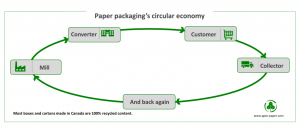Last week, The Ottawa Citizen’s Kelly Egan wrote an article about cardboard recycling in Canada. In Thinking inside the box — pandemic creates crush of new cardboard, Egan provides some stats about paper packaging recycling and the consumption of trees — some of which are correct, and some of which are confusing.
Egan reached out to the Paper and Paperboard Packaging Environmental Council (PPEC) for some information on paper recycling, and while he used some of the data we provided, PPEC was not mentioned in the article.
With regards to recycling, Egan wrote:
“Paper and cardboard are considered the success stories in the recycling world. Two main reasons: as much as 98 per cent (depends who’s counting) of corrugated cardboard is recycled and any “new” cardboard uses very high content of recycled fibre.”
Yes, paper and cardboard are indeed success stories, and PPEC and the Canadian paper packaging industry is proud of that. As for who’s counting, it is Stewardship Ontario (who operates the Blue Box program under the authority of the The Waste-Free Ontario Act, 2016) who is doing the counting. Ontario’s 98% recovery rate for corrugated cardboard, the most recent available data, is from the 2020 Blue Box Pay-In Model.
As for recycled content, most of the paper packaging material made by Canadian mills today is 100% recycled content, according to PPEC’s most recent Recycled Content Survey. Old corrugated boxes and cartons are collected through residential Blue Box recycling programs across the country, as well as from the factories and supermarkets, and used to create recycled content product.

Egan goes on to write about tree consumption:
\”While this is considered a shining example of the so-called circular economy, paper and cardboard production does gobble up a lot of trees, as per this snippet from a recent Washington Post story: “Global consumption of trees reaches roughly 15 billion each year, including three billion for paper packaging, according to the Environmental Paper Network. The industry relies on recycling virgin fibre — the basis of cardboard boxes — five to seven times, saving trees and improving the bottom line.”
The Washington Post story Egan is quoting from is How Big Cardboard is handling the 2020 box boom (December 30, 2020). But using a global figure about tree consumption, in an article about paper packaging in Ottawa, could lead to some unnecessary confusion.
When it comes to Canada’s trees, less than half of one per cent of our forests are harvested for pulp, paper and lumber uses each year. In 2018, the harvested area represented 0.2% of the total area of forest land, according to Natural Resources Canada. And by law, all forests harvested on crown land (over 90% of Canada’s forest land is publicly-owned) must be successfully regenerated.
Not that we use of lot of trees to make paper packaging to begin with. On average, the recycled content of paper packaging shipped domestically is 71 per cent; and the balance of Canadian paper packaging comes from wood residues – wood chips, shavings and sawdust left over from lumber operations – with only 11% coming directly from trees (roundwood pulp), according to PPEC’s The Truth About Trees members only Fact Sheet.
According to the Washington Post article Egan quoted from, virgin fibre is recycled five and seven times; but according to our information, paper fibres can be recycled between four and nine times in Canada.
And while Egan refers to the “so-called circular economy,” PPEC truly believes that we do have a circular economy for paper packaging. Our Paper Packaging Flow Chart shows the cycle of how our material is collected, sorted, and sent to recycling mills to make new packaging; illustrating the circularity in the manufacture and use of paper, a renewable, sustainable and recyclable resource.

Well said. I have fired off a letter to the Ottawa Citizen.
I’m also intrigued by the claim attributed to the Environmental Paper Network that the corrugated industry “relies on recycling virgin fiber.” I thought once you lost your virginity that was it. So I’m still a virgin then?